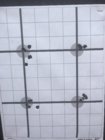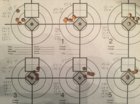I’ll redo this test with the hornady brass and see what happens.
To answer your previous question about if it is a new barrel or not, I don’t know. I got it used but it could have very few rounds through it based on the look of the rifle but who knows.
I was planning on starting a different load work up anyway with the new brass and another bullet, do you use a similar ladder test to start and then do what you advised or how would you start?
Any change that could result in a different powder burn rate (i.e. new Lot of powder or change in primers), case volume (i.e. a new Lot of brass, or different brand of brass), or variance in bullet dimensions (i.e. new Lot of bullets), necessitates at the very minimum enough testing to determine whether the load is shooting the same as it was before the change was made.
The problem with load development procedures that use a very small number of total rounds is that almost by definition, you're testing fairly wide increments in order to cover a sufficiently wide range. Without further fine increment testing, you'll never really know where in the "window" a coarse increment load actually is. Is it right in the middle of the window? Is it right on the very edge? Obviously the latter case will be more prone to going out of tune as conditions change.
There are a variety of charge weight tests including ladders, OCW, etc. Although there are subtle differences in the testing methods, they are essentially all looking at elevation in response to varying charge weight. Both can work. BR shooters tend to favor the ladder approach. F-Class shooters tend to use either (both) approaches.
Ultimately, the key to successful testing may not necessarily be which approach you choose, but how carefully you carry out the testing and interpretation. Clearly the discipline you intend to shoot should influence your choice of methods. But it's also important to point out that with any method, testing increments cannot be too coarse, or the information you get in return is limited at best (i.e where is a given load actually located within some optimal window?). On the other hand, testing exceedingly small increments on the first pass when all you're really looking for is the right neighborhood to test further can sometimes be a waste of time and effort. I think most people try to find an acceptable balance between the two, and it may take time and experience to know in advance where that balance may be.
Regardless of the approach you choose, your initial charge weight testing should cover a sufficient charge weight range to reveal at least one potential accuracy node, maybe two or more. So you can certainly use a coarser charge weight increment such as 0.5 gr to cover a wider overall range initially and minimize the total number of rounds necessary. Regions that look promising can then be tested further in small increments to better define the boundaries of any "optimal" window you find.
Even if I don't use it, I understand the reasoning behind a "10-round" load development approach. I also have no doubt there are those that have been very successful and satisfied with this approach. However, I have gotten the feeling as this thread has progressed that you are becoming more and more lost with the process of load development. Maybe it's time to think less about the total number of rounds used for testing and focus more on a methodical stepwise and incremental approach, regardless of how many rounds it takes.
Your groups at 42.5 gr above give you a good starting reference point, even if you decide to change brass. For that reason, I would suggest trying to reproduce the 42.5 gr grouping and velocity. Changing brass will likely change case volume and therefore pressure/velocity. However, the expected changes shouldn't be huge, as 2-3 gr. It's far more likely you will observe a more subtle change. So use your 42.5 gr load as a reference or starting point, and test in finer increments (maybe 0.2 gr per test point) on either side of that, making sure you cover a sufficiently wide window in the process. I doubt you would need to test more than about 0.6 gr to either side to fully cover the window, even if it has shifted slightly to one side or the other due to using the Hornady brass. Further, your previous velocity at 42.5 gr will also be a good indicator as to what the switch to Hornady brass accomplished. Unless I'm mistaken, the Hornady brass should have greater case volume than Lapua. Therefore, you would anticipate achieving slightly lower velocity at a given charge weight. If that assumption holds, you'd know right away that you're going to need more than 42.5 gr to hit the same velocity, and can adjust the test window accordingly, if necessary. Once you find similar grouping with the new brass, you can move on to a seating depth test, at which point you ought to be close to where the rifle is shooting optimally.















